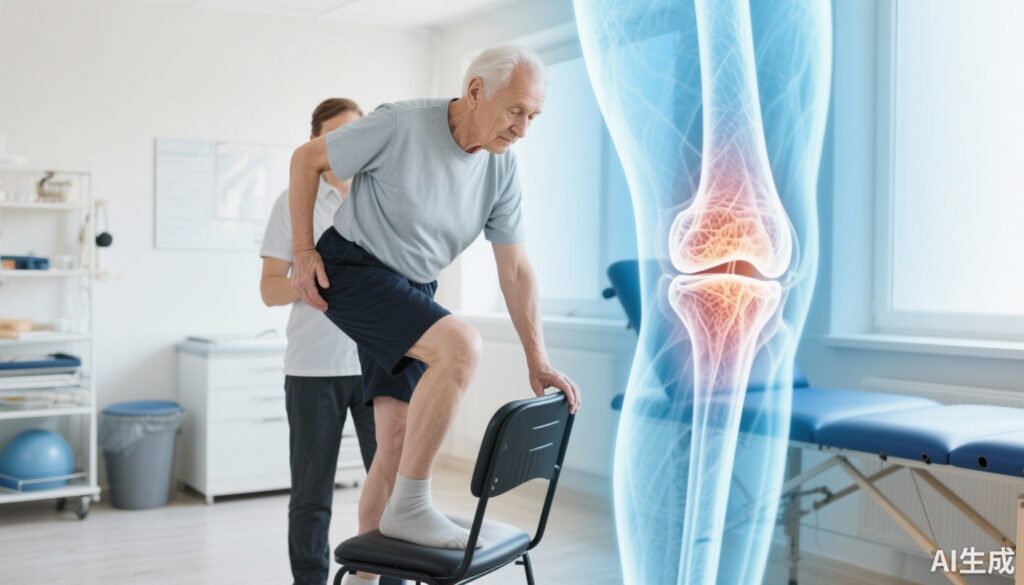Highlight
– Baseline sarcopenia defined using SARC-F and the five-times chair-stand test (probable sarcopenia) was common in the Osteoarthritis Initiative cohort (27.2% and 16.8%, respectively).
– Both screened and probable sarcopenia were independently associated with greater radiographic and symptomatic knee osteoarthritis (KOA) progression over 24 and 48 months.
– Sarcopenia at baseline predicted substantially higher risk of subsequent knee replacement (Scre-S HR 3.84, 95% CI 3.18–4.62; Prob-S HR 2.29, 95% CI 1.87–2.81); associations persisted after adjustment and propensity-score matching.
Background
Knee osteoarthritis (KOA) and sarcopenia are highly prevalent conditions in older adults that often coexist. KOA is a leading cause of pain, disability, and knee replacement (KR), while sarcopenia—the loss of muscle strength and mass—contributes to frailty, falls, and functional decline. Clinicians and researchers have long suspected a bidirectional relationship: muscle weakness could worsen joint loading and disease progression, while pain and limited mobility from KOA could accelerate muscle loss. However, prospective evidence linking sarcopenia to objective KOA progression and the eventual need for KR has been inconsistent.
Study design
Wu and colleagues performed a longitudinal analysis using data from the Osteoarthritis Initiative (OAI). The primary exposure was baseline sarcopenia, screened following the EWGSOP2 algorithm using the SARC-F questionnaire (screened sarcopenia; Scre-S), with further functional assessment by the five-times chair-stand test to identify probable sarcopenia (Prob-S).
Outcomes included radiographic KOA progression assessed by changes in Kellgren–Lawrence Grade and Osteoarthritis Research Society International (OARSI) atlas scores at 24 and 48 months, symptomatic progression by the Western Ontario and McMaster Universities Osteoarthritis Index (WOMAC), and subsequent knee replacement (KR) during follow-up.
The authors analyzed associations before and after multivariable adjustment for key confounders and performed propensity score (PS) matching to mitigate bias from measured covariates.
Key findings
Population and exposure prevalence
The analytic sample comprised 4,316 participants from the OAI. At baseline, 27.2% met criteria for screened sarcopenia (SARC-F positive) and 16.8% met criteria for probable sarcopenia when the chair-stand test was incorporated.
Radiographic and symptomatic progression
Both Scre-S and Prob-S at baseline were positively associated with radiographic progression (worsening KLG and OARSI scores) and symptomatic progression (increases in WOMAC scores) over 24 and 48 months. The associations were observed across multiple radiographic and symptom-based endpoints, indicating that sarcopenia-related vulnerability affects both structural and clinical disease expression.
Risk of knee replacement
Baseline sarcopenia was associated with substantially higher risk of subsequent knee replacement. For screened sarcopenia, the hazard ratio (HR) for KR was 3.84 (95% CI 3.18 to 4.62). For probable sarcopenia, the HR for KR was 2.29 (95% CI 1.87 to 2.81). These large effect sizes persisted after multivariable adjustment and in PS-matched cohorts, strengthening the likelihood that the observed relationships are not fully explained by measured confounding.
Sensitivity and robustness
Associations remained significant in propensity-score matched analyses, which sought to balance baseline characteristics between sarcopenic and non-sarcopenic groups. The longitudinal design—baseline sarcopenia predicting later progression and KR—supports temporal precedence, a criterion for causality in observational research.
Expert commentary and interpretation
Why might sarcopenia increase KOA progression and KR risk?
Several mechanistic pathways plausibly link sarcopenia with faster KOA progression. Reduced thigh muscle strength and mass decrease dynamic joint stabilization and shock absorption, potentially amplifying mechanical stress on articular cartilage. Weakness may alter gait patterns, increase varus/valgus moments, and unevenly distribute load across the tibiofemoral compartments. In addition to mechanical factors, sarcopenia is associated with systemic inflammation and altered myokine profiles that could influence joint tissue metabolism.
Clinical implications
These results suggest that sarcopenia is not merely a comorbidity but could be a modifiable driver of KOA deterioration. The magnitude of the association with KR—particularly the nearly fourfold hazard with SARC-F screened sarcopenia—signals that identifying and addressing muscle weakness could meaningfully influence clinical trajectories.
Screening and assessment
The study operationalized sarcopenia using readily available tools: the SARC-F questionnaire for initial screening and the five-times chair-stand test for probable sarcopenia. These measures are practical in outpatient and primary care settings and can identify patients at higher risk of progression who may benefit from targeted interventions.
Strengths and limitations
Strengths
– Large, well-characterized longitudinal cohort with standardized radiographic and symptomatic assessments at multiple time points.
– Use of both screening and objective functional tests to define sarcopenia, together with rigorous analytic approaches including multivariable adjustment and propensity-score matching.
Limitations
– Observational design: despite temporal sequencing, residual confounding and unmeasured factors (e.g., detailed physical activity patterns, muscle mass quantified by imaging, or nutritional status) may influence results.
– Sarcopenia definition relied on SARC-F and chair-stand performance rather than direct measures of appendicular muscle mass (e.g., DXA or CT). While EWGSOP2 endorses these screening and functional measures, some participants with low muscle mass but preserved function could be misclassified, and vice versa.
– Generalizability: the OAI cohort has specific inclusion criteria and demographic composition which may not represent all clinical populations globally.
– Reverse causation cannot be completely excluded: while baseline sarcopenia predicted later outcomes, subclinical KOA trajectory could have influenced baseline performance. However, the magnitude and persistence of associations after adjustment make this less likely to fully explain findings.
Practical recommendations and future directions
Clinical practice
– Screen patients with KOA for sarcopenia using simple tools (SARC-F and chair-stand test) as part of holistic assessment, especially in older adults or those with functional decline.
– For patients identified with probable sarcopenia, consider early referral to physiotherapy for progressive resistance exercise and neuromuscular training, which target strength, balance, and function—interventions that are safe and effective for many older adults and recommended by sarcopenia guidance documents.
– Address nutritional contributors to sarcopenia (adequate protein intake, correction of vitamin D deficiency when present) and optimize management of comorbidities that may accelerate muscle loss.
Research
– Randomized controlled trials are needed to test whether targeted treatment of sarcopenia (exercise, nutritional supplementation, multimodal rehabilitation) can slow structural and symptomatic KOA progression and reduce the need for knee replacement.
– Studies incorporating direct measures of muscle mass and quality (DXA, MRI, CT) alongside functional tests will clarify which components of sarcopenia (mass vs strength vs power) most strongly contribute to KOA outcomes.
– Mechanistic research on muscle–joint crosstalk, loading patterns, and inflammatory mediators would help design tailored interventions.
Conclusion
Wu et al. provide compelling longitudinal evidence that baseline sarcopenia—assessed by pragmatic screening and functional testing—is associated with faster radiographic and symptomatic KOA progression and markedly higher risk of subsequent knee replacement. The findings reinforce the conceptualization of sarcopenia as a clinically important, potentially modifiable determinant of KOA outcomes. Integrating routine sarcopenia screening into OA care and testing interventions that strengthen muscle could become important strategies to alter KOA trajectories and reduce the burden of knee replacement surgery.
Funding and trial registration
Primary study reference lists funding sources and cohort governance; the reported analysis used the Osteoarthritis Initiative dataset. Wu T et al. report the study in Arthritis Rheumatol. (See reference below.)
References
1. Wu T, Wang X, Cai Z, Cao P, Dang Q, Zhou W, Xie J, Chen J, Wang T, Tao G, Han W, Zhu Z, Wang J, Hunter DJ, Barazzoni R, Ding C, Li J. Longitudinal Associations Between Baseline Sarcopenia and Knee Osteoarthritis Progression and Risk of Knee Replacement. Arthritis Rheumatol. 2025 Oct;77(10):1362-1372. doi: 10.1002/art.43213. Epub 2025 Jun 19. PMID: 40325921.
2. Cruz-Jentoft AJ, Bahat G, Bauer J, et al. Sarcopenia: revised European consensus on definition and diagnosis. Age Ageing. 2019;48(1):16-31. doi:10.1093/ageing/afy169.
3. Kellgren JH, Lawrence JS. Radiological assessment of osteo-arthrosis. Ann Rheum Dis. 1957;16(4):494–502.
AI-friendly thumbnail prompt
A bright physiotherapy clinic scene: an older adult in light exercise clothes doing a five-times chair-stand test under supervision of a therapist; to the right, a semi-transparent medical X-ray of a knee showing joint space narrowing and osteophytes; soft warm lighting, clinical but empathetic tone, photorealistic, 3:2 aspect ratio.



